Five centuries of accuracy. Snipers
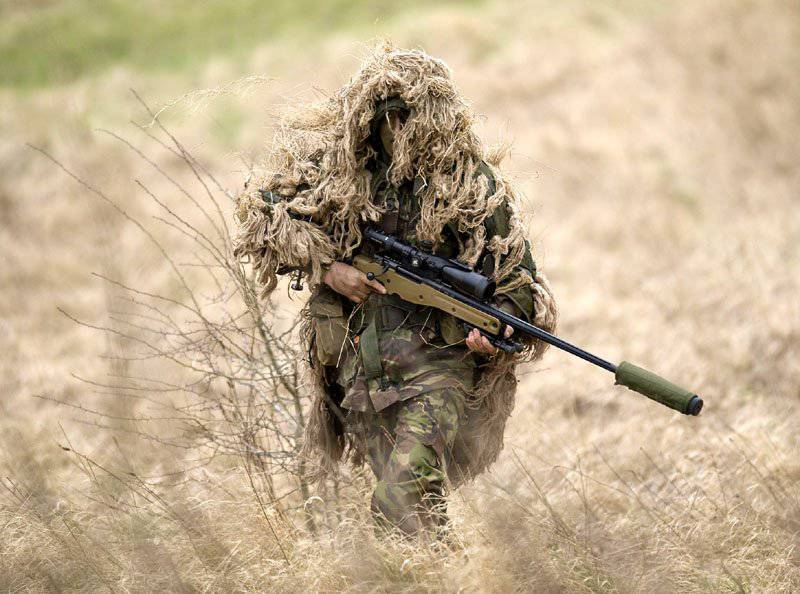
Cases of bygone days
Events that can be considered the birth of modern sniper art, occurred in the XVII century. Then the participants of the Civil War in England began to use long-barreled hunting rifles for military purposes. One of the most famous cases of their use was a shot by a soldier, John Dyota, from a distance of about 140 meters caught in the eye of an enemy commander. The effective range of fire of most types of small arms then barely reached 70-80 meters. The case was widely publicized, after which the number of shooters with long-range guns on both sides of the conflict increased significantly. Around this time, well-aimed shooters begin to be called the term snipe shooter - the snipe hunter. The fact is that in order to hunt for this small bird, it was necessary to mask well, move quietly and shoot straight. Somewhat later, the name of apt shooters is converted into a short and familiar sniper.
After the end of the Civil War, tactics of firing from long distances were forgotten for a while. Again, she had to be remembered during the War of Independence of the United States, but this time the British had to develop countermeasures. A lot of shooters from the army of patriots, learning to fire at relatively large distances, brought many problems to the loyalists. They regularly organized shelling camps, carts and columns on the march. Due to the smaller range of mass loyalist infantry weapons, the only effective countermeasure in such situations was artillery. However, the preparation of weapons under the fire of the enemy is not easy, besides, by the time of the first shot, the patriot sniper managed to withdraw from the position. The English arrows, it should be noted, tried to adopt this tactic, but such initiatives did not evoke enthusiasm from the command. Therefore, in the army of loyalists a large number of snipers never appeared.
At the very beginning of the 19th century, sniper fire was rarely used, but, as they say, aptly — then the British and French “exchanged” well-aimed shots at General Colbert and Admiral Nelson. Both military leaders died. But the real flowering of the sniper case dates back to the middle of the same century. At this time, the leading countries switched to rifled needle weapons, which had far greater levels of combat than their predecessors. In addition to this, the English army finally began to purposefully train the shooters for sniper work and to give them fittings with specially made sights. During the Crimean War, English snipers delivered many problems to the Russian army, because finding and crushing an enemy shooter is not easy and quick. And before that, he will have time to hurt at least several people. A little later, in the Anglo-Boer Wars, the African arrows adopted the English experience, and again the troops of Albion had to hide from single, but such dangerous bullets. In the second half of the XIX century, in many armies a sign of a match appeared: one cannot be lit from three. The reason for it is simple and lies in the features of sniper work at night. When the first person lights up, the sniper discovers him by the light. When a match moves to the second soldier, the sniper gets a rough idea of his location and can make a lead in the direction of the third. Accordingly, when the third soldier is just starting to light, the sniper has already fired in the right direction. Snipers proved to be so effective a means of warfare that, in some cases, only accurate marksmen dispersed on the ground opposed full-fledged units of the English army.
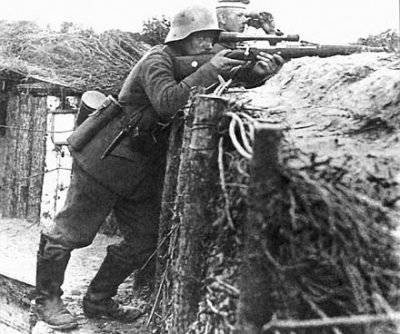 Trench sniping
Trench snipingWorld wars had a huge impact on all types of armed forces, military equipment, and also made adjustments to military science, including sniper art. In 1915, the German command ordered the introduction of sniper shooters into the staff of the units. By this time, all European armies had switched to magazine rifles, and the Germans, moreover, had time to adjust the large-scale production of optical sights. All this made it possible to prepare a huge number of snipers: in some companies there were six to seven people each. The peculiarities of the positional warfare, namely a large number of trenches directly on the front line, allowed the German riflemen to launch such vigorous activity that the enemy soldiers were sometimes afraid to pop out of their shelters. In addition, snipers to some extent influenced the military uniform: in order to avoid losses, junior officers in armies began to introduce field epaulets, signs on which it was impossible to distinguish from a long distance.
With some delay after the Germans, the United Kingdom also created its sniper schools. They distinguished themselves in accuracy and sent them to special courses (total 17 days), where they were taught everything they could learn in such a short period of time. But the British had a serious problem: not all graduates of the courses were ready for serious sniper work. Most often they had problems with disguise. As a result - big losses among newly minted snipers. But the survivors, thanks to their skills, influenced the development of the entire world of sniping. It was the English shooters who first invented camouflage suits and models of front-facing objects that serve as shelter for the sniper. Later this practice was adopted by all the belligerents, and costumes from a variety of fabric elements imitating greens are still used. It is clear that the appearance of a sufficient number of snipers from opponents of Kaiser Germany led to the first sniper duels, which later became common practice. The fact is that the same professional can best deal with the fight against a professional sniper.
In the Russian Empire, the first riflescope, suitable for use with existing weapons, appeared only in the 1914 year, and due to various problems it went to the troops only at the end of the 16. Needless to say, the Russian snipers did not have any outstanding achievements, at least because of the short time remaining until the country's withdrawal from the First World War.
On the threshold of World War II
Sufficient attention to snipers in our country began to be paid only at the end of the 20-s. Then at the highest shooting courses "Shot" a special training course for snipers was organized. After a few years, some courses of OSOAVIAHIM will join the “Shot” in this matter. The main weapon of the sniper then was a Mosin rifle with an optical sight. At the end of 30-x a sniper version of Tokarev SVT-40 self-loading rifle will be created, but its production will soon be curtailed due to insufficient accuracy. As a result, all measures to the beginning of the Second World War by snipers in the Soviet Union went to the thousands.
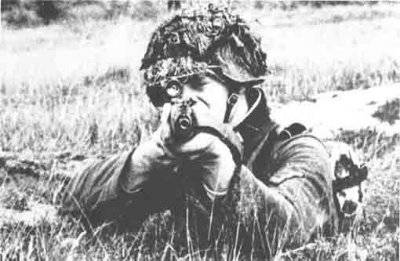 However, not all shooters from this huge number possessed all the necessary skills. This fact is considered one of the main reasons for the success of Finnish snipers in the Soviet-Finnish war. The enemy arrows knew the terrain and the particular conditions in which they had to fight. Particularly distinguished Simo Hyaha, on account of which more than 200 killed soldiers and officers. It should be noted that numerical indicators of the effectiveness of sniper work are somewhat similar to the accounts of aces pilots: all the same problems with accurate counting, fixing a successful shot / shot down and, as a result, numerous disputes, misinterpretations and legends. For example, it is often argued that Hähähya, in just three months spent at the front, destroyed more than half a thousand Red Army men. But the main merit of the Finnish sniper is the creation of a secret set of rules and camouflage techniques that ensure success. In various variations and with appropriate changes, the Häyhä experience is still used.
However, not all shooters from this huge number possessed all the necessary skills. This fact is considered one of the main reasons for the success of Finnish snipers in the Soviet-Finnish war. The enemy arrows knew the terrain and the particular conditions in which they had to fight. Particularly distinguished Simo Hyaha, on account of which more than 200 killed soldiers and officers. It should be noted that numerical indicators of the effectiveness of sniper work are somewhat similar to the accounts of aces pilots: all the same problems with accurate counting, fixing a successful shot / shot down and, as a result, numerous disputes, misinterpretations and legends. For example, it is often argued that Hähähya, in just three months spent at the front, destroyed more than half a thousand Red Army men. But the main merit of the Finnish sniper is the creation of a secret set of rules and camouflage techniques that ensure success. In various variations and with appropriate changes, the Häyhä experience is still used.Nevertheless, Soviet snipers got their high point. He came to the Great Patriotic War. In the first months of the war, our arrows interfered so much with the German offensive that the Wehrmacht command was forced to re-organize the sniper courses that were closed after the end of the First World War. In quantitative terms, over time, the Germans managed to catch up with the Soviet snipers, but there were also "qualitative" differences. So, in the Red Army there were a considerable number of female snipers, and they fought no worse than their male counterparts. Perhaps the most famous of them was Lyudmila Pavlichenko. Until June 42, she managed to destroy 309 enemy soldiers and officers, among whom were 36 snipers. But after achieving such results, she was injured and never returned to the front - she was appointed an instructor in the “Shot” courses. In addition, in the United States L. Pavlichenko is known for her question at a rally in Chicago, where she was on the Soviet delegation: "I am twenty five years old. At the front, I had already managed to destroy three hundred and nine fascist invaders. Do you think, gentlemen, that you have been hiding behind my back too long ?! ”. Other girls snipers, Alia Moldagulova, Natalia Kovshova and Maria Polivanova, Rosa Shanina, and others, have made smaller accounts. But even with their complex and routine work they were bringing the Victory closer.
No worse than the girls fought and male snipers. Perhaps the most famous of them was Vasily Zaitsev. In November-December alone, 42, during the Battle of Stalingrad, Zaitsev destroyed almost two and a half hundred officers and soldiers and 11 snipers. Also in Stalingrad, Zaitsev had a duel with a German sniper several days long, based on which then the film would even be made. The Soviet sniper himself in his memoirs called the enemy Major Kening, but in later sources it is stated that the chief of the SS sniper school in Tsossen Shtarendenführer SS G. Torvald was specially sent to hunt Soviet snipers. A few days in positions, a wounded partner, broken optics from another, and as a result just a single shot, after which the German school needed a new boss. At the beginning of the 1943 of the year, interfering with the German offensive, Zaitsev received a severe wound, due to which he almost completely lost his sight. V. Filatov himself began to restore the health of the sniper and after several operations a month later Zaytsev could see again. February 22 V. Zaitsev received the title of Hero of the Soviet Union. Until the end of the Great Patriotic War, this sniper managed not only to increase his combat score, but also to write several textbooks on the sniper case.
As for the German snipers, they also brought a lot of problems to the Red Army. However, the most frequently mentioned are from the actions in the West European theater of military operations of the Second World War. The Americans and Englishmen who landed in Normandy did not have the necessary skills and experience to deal with enemy snipers. In addition, in those regions widespread were hedges, in which German snipers often arranged their positions. In the first time, the main means of the allies against enemy shooters were mortars, but subsequently their own arrows were added to them. In a short time, the States and England had to create and restore their school of sniper art. However, the war was already coming to an end, and the Americans and the British failed to achieve significant accounts.
New time and new trends
Until a certain time, snipers were “chosen” - they were few, and anyone could envy the skills and abilities. But the new time always carried new ideas, and another confirmation of this thesis was a new concept from the USSR. Domestic commanders decided that in addition to the machine-gunners, the infantry or motorized rifle units should be supported by snipers. This approach to the sniper case was called the "infantry sniper". The SVD rifle was created as a weapon for these soldiers. There are still disputes over whether it makes sense to introduce one’s own sniper into the divisions and how effective his job is. However, in many countries, the specialty infantry sniper was introduced. The situation with the SVD is the same: many people criticize, but no fewer use it and are not going to refuse. Probably, the fact is that this weapon copes well with the tasks for which it was done.
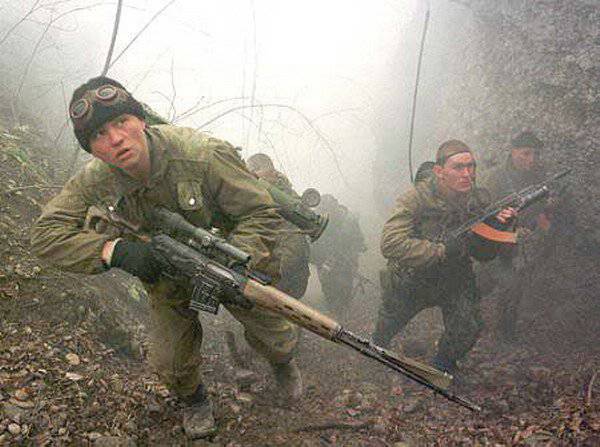
The end of the 20th century demanded the creation of a new sniper specialization: the number of hostage situations increased, and the fighting in the city almost completely ceased to amaze anyone. All this led to the emergence of the so-called. police sniping. From infantry or sabotage sniping (so often referred to as the "classic" work of the shooter with ambushes, camouflages, etc.) it is primarily distinguished by the distance: they usually do not exceed 150-200 meters. However, short distances do not make the profession of a police sniper easier. The fact is that the targets in such cases also turn out to be smaller: for example, often you have to shoot at the hand of a criminal in which he holds a gun. You can imagine what kind of training is required for such accuracy.
In a relatively short period of time, two new sniper specializations appeared at once. However, the development of this art does not stand still and continues. For example, in the 80-ies of the last century, a new class of sniper weapons - large-caliber rifles. It should be noted that attempts to “fit” the cartridge 12,7х99 mm to the sniper case have been made before. The most famous case is the record of the American shooter K. Heskok, established in the Vietnam War. From a specially modified Browning M2 machine gun with a telescopic sight, Hascock was able to shoot a Vietnamese soldier who was at a distance of about 2250 meters. Until 2002, it was the official world record.
One of the first serial large-caliber sniper rifles, and probably the most famous of them, was the Barrett M82, created by Ronnie Barrett in 1982 and adopted by the early 90's. Thanks to the powerful cartridge, this weapon strikes targets at ranges up to 1800 meters, and the sniper’s target can be not only the enemy’s manpower, but also vehicles, light-armored vehicles, etc. In our country, the development of such weapons began only after the collapse of the Soviet Union, and the initial tactical niche for large-caliber rifles was considered to be a fight against enemy snipers. Hence the term "anti-sniper rifle." The first such model was the Volga B-94 rifle, created in the Tula KBP. Later, the Volga was modified and made with the OCB-96 rifle, which differs from the original series of innovations that provide greater convenience for the shooter. The ammunition of both rifles is the same - 12,7x108 mm, and the range and accuracy are almost the same as those of the Barrett. After the WWS-96 in our country, rifles KVSK (Kovrovsky Mechanical Plant), VSSK Vykhlop (Tula TsKIB SOO) and a number of other types were created. Some of them managed to enter into service with the power structures of Russia.
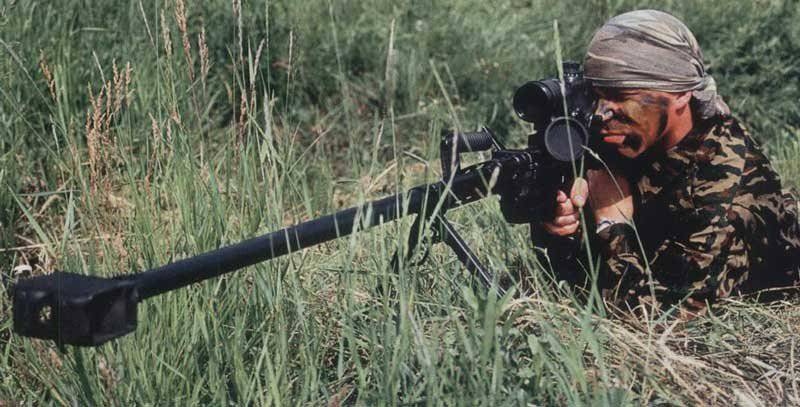
Another trend in the development of sniper weapons was the rejection of the automatic mechanism of rifles. At one time, the possibilities of self-loading and self-arming were considered to be an important advantage of weapons, but subsequently they gained great popularity by views implying a “return to the roots”. A large part of self-loading sniper rifles has automatics with a gas engine, and it requires the selection of some of the powder gases, which slightly reduces the effective range of fire. In addition, while the bullet moves along the barrel, the bolt of the rifle also has time to move and change the balancing of the latter. As a result, there is a slight displacement of the trunk, which reduces accuracy. Weapons with a longitudinally sliding gate and manual reloading do not have such flaws, although at the price of a lower rate of fire. But the sniper fire rate is almost always just not needed. The Austrian Steyr SSG69, which is in service with many countries and became the basis for several new types of rifles, has become the most famous representative of the new generation of automatic weapons.
In addition to manual recharge in recent years, more and more new designs are being created by the so-called. skeletal pattern. With this arrangement, the receiver is attached to a special frame, which, in turn, is attached to the bed. Such a design behaves more reliably than the usual, and if the gun box or butt is damaged, the “firing unit” of the weapon suffers much less. Thus, it is enough to replace the damaged parts and, if necessary, re-adjust the arrow.
***
For quite objective reasons, it is impossible to foresee the development of a sniper case in the future with an absolute probability. But now, based on existing trends, you can build your assumptions. For example, in our country we can expect the appearance of a large number of snipers who have undergone appropriate training. Last year, special schools were created in the military districts of Russia to train professional snipers. Of course, there is no open access to detailed information about the training methods or service points of these schools, but the available information suggests that not sniper but not international infantry is trained, so to speak, in the international sense. As for police sniping, he will most likely develop in the same directions as before - after all, there are no strong changes in the working conditions for such specialists and are not foreseen.
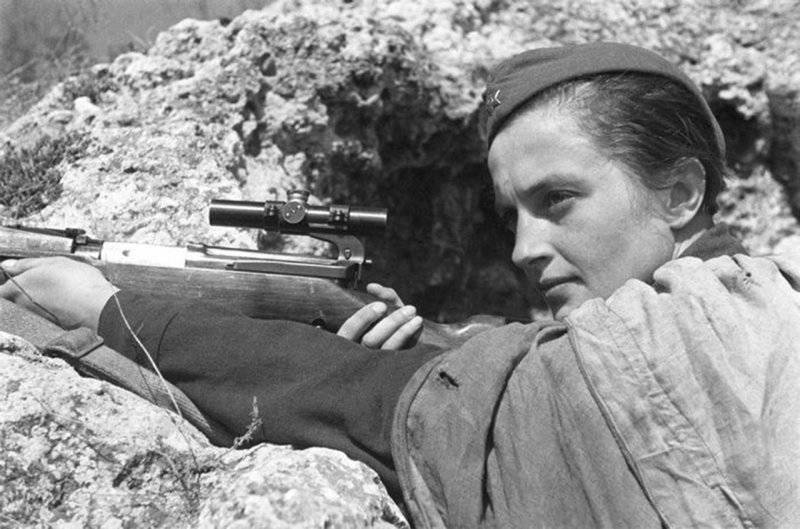
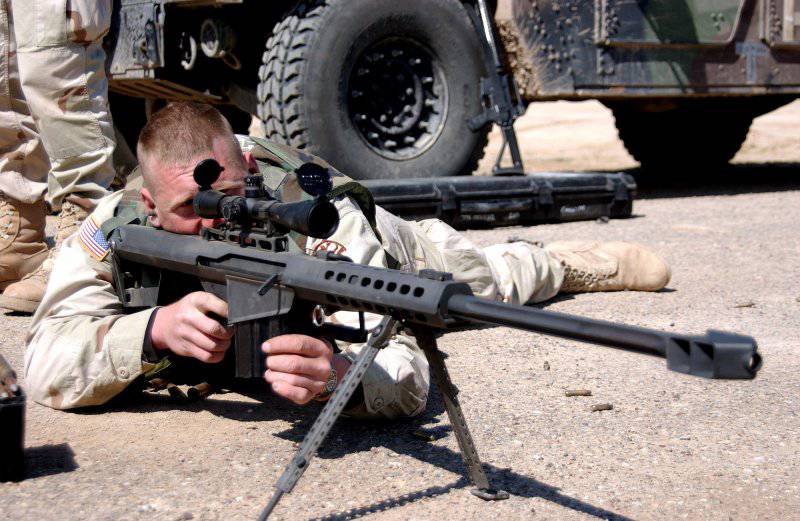
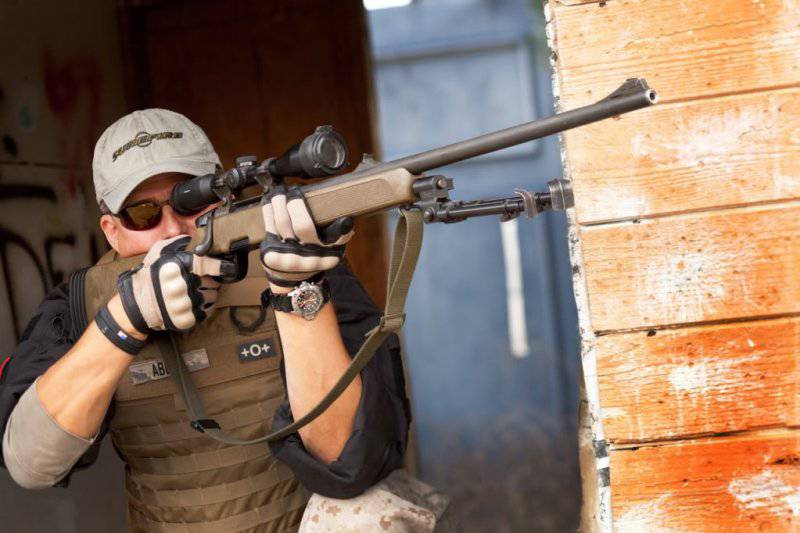
Information